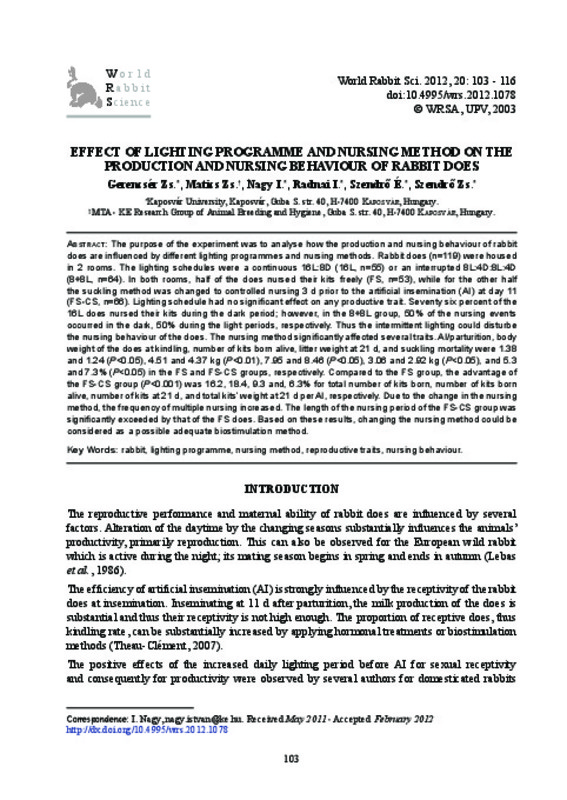JavaScript is disabled for your browser. Some features of this site may not work without it.
Buscar en RiuNet
Listar
Mi cuenta
Estadísticas
Ayuda RiuNet
Admin. UPV
Effect of lighting programme and nursing method on the production and nursing behaviour of rabbit does
Mostrar el registro sencillo del ítem
Ficheros en el ítem
| dc.contributor.author | Gerencsér, Zsolt
|
es_ES |
| dc.contributor.author | Matics, Zsolt
|
es_ES |
| dc.contributor.author | Nagy, István
|
es_ES |
| dc.contributor.author | Radnai, I.
|
es_ES |
| dc.contributor.author | Szendrõ, Éva
|
es_ES |
| dc.contributor.author | Szendrõ, Zsolt
|
|
| dc.date.accessioned | 2012-07-19T07:13:57Z | |
| dc.date.issued | 2012-06-30 | |
| dc.identifier.issn | 1257-5011 | |
| dc.identifier.uri | http://hdl.handle.net/10251/16711 | |
| dc.description.abstract | [EN] The purpose of the experiment was to analyse how the production and nursing behaviour of rabbit does are influenced by different lighting programmes and nursing methods. Rabbit does (n=119) were housed in two rooms. The lighting schedules were a continuous 16L:8D (16L, n=55) or an interrupted 8L:4D:8L:4D (8+8L, n=64). In both rooms, half of the does nursed their kits freely (FS, n=53), while for the other half the suckling method was changed to controlled nursing 3 days prior to the artificial insemination (AI) at day 11 (FS-CS, n=66). Lighting schedule had no significant effect on any productive trait. 76% of the 16L does nursed their kits during the dark period; however, in the 8+8L group, 50% of the nursing events occurred in the dark, 50% during the light periods, respectively. Thus the intermittent lighting disturbed the nursing behaviour of the does. The nursing method significantly affected several traits. AI/parturition, body weight of the does at kindling, number of kits born alive, litter weight at day 21, and suckling mortality were 1.38 and 1.24 (P<0.05), 4.51 and 4.37 kg (P<0.01), 7.95 and 8.46 (P<0.05), 3.06 and 2.92 kg (P<0.05), and 5.3 and 7.3% (P<0.05) in the FS and FS-CS groups, respectively. Compared to the FS group, the advantage of the FS-CS group (P<0.001) was 16.2, 18.4, 9.3 and, 6.3% for total number of kits born, number of kits born alive, number of kits at day 21, and total kits¿ weight at day 21 per AI, respectively. Due to the change in the nursing method, the frequency of multiple nursing increased. The length of the nursing period of the FS-CS group was significantly exceeded by that of the FS does. Based on these results, changing the nursing method can be used as an adequate biostimulation method. | es_ES |
| dc.description.sponsorship | Financial help from TECH_08_A3/2-2008-0384, NDA (National Development Agency) is gratefully acknowledged. | |
| dc.language | Inglés | es_ES |
| dc.publisher | Editorial Universitat Politècnica de València | es_ES |
| dc.relation.ispartof | World Rabbit Science | |
| dc.rights | Reserva de todos los derechos | es_ES |
| dc.subject | Rabbit | es_ES |
| dc.subject | Lighting programme | es_ES |
| dc.subject | Nursing method | es_ES |
| dc.subject | Reproductive traits | es_ES |
| dc.subject | Nursing behaviour | es_ES |
| dc.title | Effect of lighting programme and nursing method on the production and nursing behaviour of rabbit does | es_ES |
| dc.type | Artículo | es_ES |
| dc.date.updated | 2012-07-19T06:40:56Z | |
| dc.identifier.doi | 10.4995/wrs.2012.1078 | |
| dc.rights.accessRights | Abierto | es_ES |
| dc.description.bibliographicCitation | Gerencsér, Z.; Matics, Z.; Nagy, I.; Radnai, I.; Szendrõ, É.; Szendrõ, Z. (2012). Effect of lighting programme and nursing method on the production and nursing behaviour of rabbit does. World Rabbit Science. 20(2):103-116. https://doi.org/10.4995/wrs.2012.1078 | es_ES |
| dc.description.accrualMethod | SWORD | es_ES |
| dc.relation.publisherversion | https://doi.org/10.4995/wrs.2012.1078 | |
| dc.description.upvformatpinicio | 103 | |
| dc.description.upvformatpfin | 116 | |
| dc.description.volume | 20 | |
| dc.description.issue | 2 | |
| dc.identifier.eissn | 1989-8886 |








